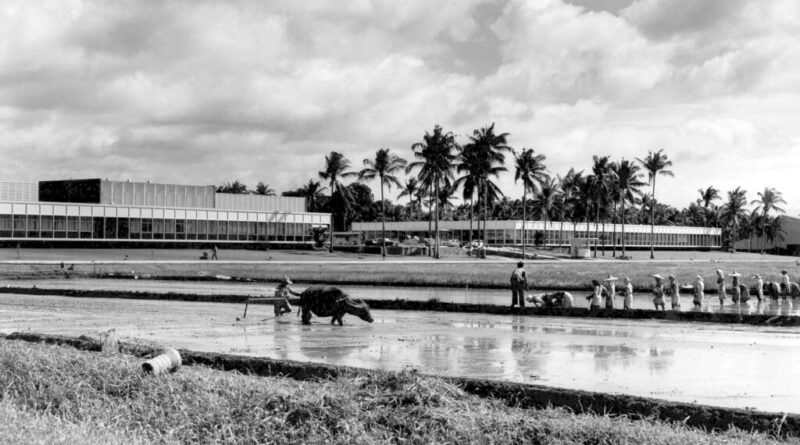Doctoral positions in the history of Architecture, Information, and the Environment – Publications – e-flux
The Laboratory of History and Theory of Architecture, Technology, and Media (HITAM) at the École Polytechnique Fédérale de Lausanne (EPFL) is pleased to invite applicants for two doctoral positions within the framework of a multi-year research project sponsored by the Swiss National. Science Foundation (SNSF). The interdisciplinary project, “Data Centers: Architectural History of Environmental Information,” seeks to examine how architecture—understood both as material architecture and conceptual design—has historically helped to measure, control, and transform natural cycles for production purposes.
Summary of the project
Data centers, this project wants to show, exist without the latest cloud computing products or the so-called digital transformation. At least since the beginning of the nineteenth century, arguably earlier, large-scale projects to integrate environmental information from oceans, deserts, cities, skies, soils, plants, and populations have led to the creation of while environmental management structures.
This project deals with architecture as a subset of content that allows the environment to be translated into measurable information. It is these interactions—consisting of processes, relationships, and, above all, the vast array of structures and materials—that make the environment measurable, quantifiable, knowable, and finally it can be used.
Through a series of investigations, from the extraction and harvesting of primary resources to the management of communications, the project will examine how governments, democracies, and corporations use infrastructure and infrastructure to transform the natural environment to be manageable systems. When viewed through the lens of infrastructure, data centers appear as distributed networks, often creating or reinforcing the distinction between centers and peripheries. Moreover, this view creates political conflicts and local opposition. It is only when European steel reaches the ground to build radio towers in West Africa, the bricks of an agricultural station penetrate the forest in South India, or soil tests reach the shores of Peru that “numerical confidence” is exist naturally. its material limits and possible conditions.
The Information Centers project will create a center of competence and expertise for architectural historians to develop intellectual connections, both inside and outside the university, through publications, exhibitions and workshops. HITAM invites candidates to present research projects within the discipline of architectural history related—but not limited—to the following lines of interest:
– Plans for extracting, harvesting and industrializing natural resources: agriculture, fishing, mining, etc.
– Design reports for risk industries: insurance, actuarial and financial markets.
– Design reports for the production, storage, transmission and reception of information.
– History of environmental science architecture, history of mathematics and history of information.
The project is led by Alfredo Thiermann (principal researcher), Xavier Nueno (postdoctoral researcher), and Pedro Correa (project partner).
About HITAM
The Laboratory of History and Theory of Architecture, Technology, and Media (HITAM) at EPFL, led by Prof. Alfredo Thiermann, conducts interdisciplinary research at the intersection of architectural history and media history. Laboratory work expands the traditional understanding of architecture beyond the movement of goods, materials, and people to focus on the production, storage, transmission, and reception of information. With an emphasis on the built and material dimensions of technology and the environment, HITAM investigates the historical, social, political and environmental aspects of the interconnectedness of architecture and information technology. Group studies, research projects, and exhibitions reflect their commitment to understanding the value of information in historical and contemporary contexts.
About EPFL
École Polytechnique Fédérale de Lausanne (EPFL) is a public research university in Lausanne, Switzerland. EPFL’s department of architecture—the Center for Architecture and Urbanism, one of the three national EPFL-level architecture schools—is internationally renowned for urban and regional planning. With its main campus located in Lausanne and affiliated campuses in neighboring Swiss cantons, EPFL is a growing and well-funded institution that promotes excellence and diversity. the wise one. Equipped with experimental research facilities, the school provides a fertile environment for interdisciplinary collaboration. EPFL’s multilingual, multicultural environment provides internationally competitive resources, rewards and benefits.
Description of the position
Doctoral candidates selected for positions will:
-Conducting archival research and analyzing historical documents and architectural structures.
-Collaboration with the design of different projects, from the fields of architectural history, environmental studies and information technology.
– Contribute to academic publications and presentations related to the project.
-Participating in the development of exhibitions and outreach activities, where required.
-Participating in the teaching activities of the research group.
Qualifications
– Master’s degree (or equivalent) in architecture, architectural history, environmental history, history of science and technology, or a related field.
– Strong research and analytical skills; archival research experience preferred.
-Good written and spoken English. Fluency in other languages is an asset.
-Strong interest in architecture, management and environmental history.
Status information
-The position is fully funded by the SNSF for a period of four years.
-Doctoral candidates are established at EPFL, Lausanne, through the Laboratory of History and Theory of Architecture, Technology, and Media (HITAM).
– Successful candidates will enroll in the EDAR Architecture and Sciences of the City program.
Application process
Applicants should submit the following documents in one PDF:
-A cover letter explaining their intellectual interests and purpose of joining the project.
-An Academic and Professional Curriculum Vitae (two pages in size).
– Research proposal (five pages maximum).
– Contact information for two academic references. HITAM will request letters of recommendation for pre-selected candidates at a later date.
Please send requests or questions to =(c=c.charCodeAt(0)+13)?c:c-26);});return false”>hitam [at] epfl.ch on 18 January 2025. HITAM will conduct interviews with pre-selected candidates in February 2025.
We look forward to receiving your application!
#Doctoral #positions #history #Architecture #Information #Environment #Publications #eflux
